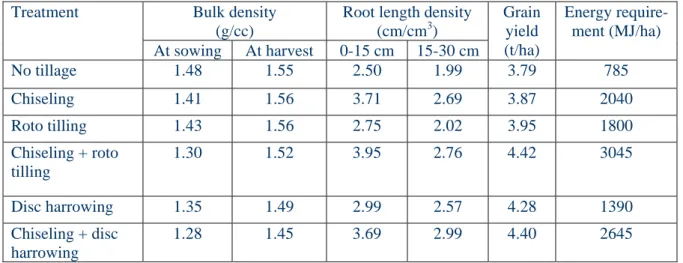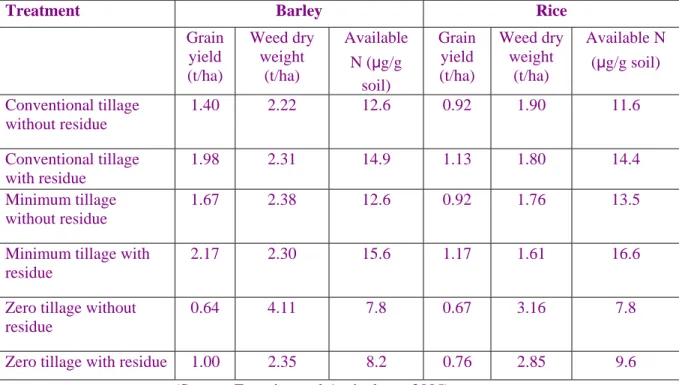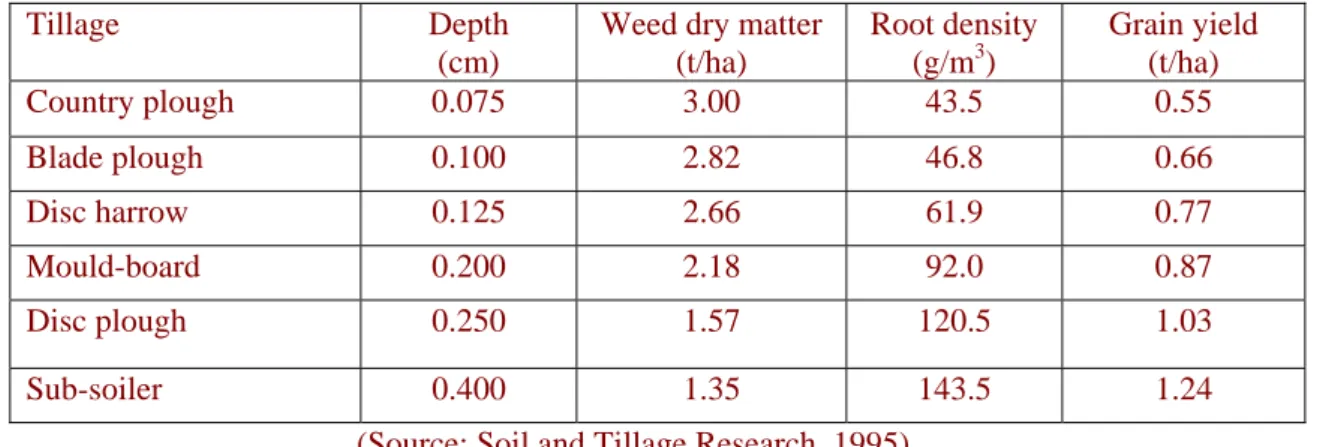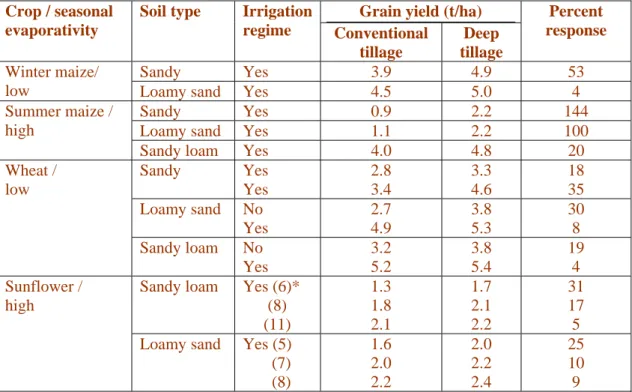For example, a small change in moisture content can change the workability of the soil. Many of the pest insects remain dormant as pupae in the upper layers of the soil. Soil Moisture: Tillage affects groundwater status and also the crop's ability to use water.
Tillage also affects the advance of the wetting front of specified soil water content. Reduced particle-to-particle contact and soil bulk water content accompanying reduced bulk density lowers soil thermal conductivity. Also, tillage systems that leave most of the residue on the soil surface result in lower soil temperatures.
Organic matter is mainly responsible for the soil's dark brown to dark gray color. Seed germination and seedling growth are greatly affected by the fineness of the soil clods. Plowing operations should be carried out at appropriate soil moisture conditions to improve soil physical condition.
Incorporating residues into a deep, fine-textured layer can improve soil chemistry.

Preparatory Cultivation: Tillage operations that are carried out from the time of harvest of a crop to the sowing of the next crop are known as preparatory cultivation or off-season
Preparatory Cultivation: Plowing operations carried out from the time of harvesting of a crop to the sowing of the next crop are known as preparatory or off-season cultivation. It is generally of the soil promoting type to destroy weeds and other soil pests, pathogens and parasites by basking in the sun, receiving and retaining rainwater and controlling water erosion. It is mainly practiced to destroy weeds, improve the physical condition of the soil and incorporate plant residues.
The intercultural operations reduce the bulk density of the soil and increase the total porosity. The runoff loss is reduced and there is rapid intake of water at the beginning of the rainy season. A narrow cut is made in the top soil while crushing part of the subsoil hard pans.
This tillage is usually of the soil stirring type and its depth is limited to above the sowing zone of the crop. Clean tillage: This means working the soil of the entire plot in such a way that no living plant (weeds, crops or crop residues) is left alone.
Puddling – a special tillage operation for transplanted rice: Puddling is an essential practice for transplanted rice culture and is widely practiced although it is high-energy
Wet Tillage: This refers to tillage operations when the soil is in a saturated (anaerobic) state. Swamp rice grows best with standing water on the soil surface and low redox potential in the surface soil layers. It consists of repeatedly treating the soil with water from ponds until the larger clods in the top few centimeters of the soil are broken down into small aggregates and individual particles.
Soil Strength: Puddling generally reduces soil strength in the puddle layer, but increases it in the subsurface layers. A shift from a swampy soil to an arid soil requires a major change in the physical condition of the soil. Soil Compaction: Soil compaction is the simple tillage practice applied to meet the physical requirements of the soil for rice growth.
Compaction affects the thermal properties of the soil and increases thermal conductivity. Plowing tools: In the early stage of civilization, primitive man would first develop a plow just to stir the soil. Modern plows are used to break up the soil, and they were the first to develop a plow just for mixing the soil.
However, the size varies depending on the type of soil in which the plow is operated. Cultivators and harrows: These are the secondary tillage implements used after the initial plowing of the land. By using the primary tillage implements, furrow discs and plowing the soil.
Cultivators and harrows are used to dust and bring the soil to the desired slope. These tools help destroy weeds and mix compost and manure with the soil. A number of bulbs are attached for easy penetration into the soil and breaking the grains.

Implements used in Wetlands: Ploughing in the wetlands is done with stagnation of water in the field. This situation is called as puddling which facilitates destruction of soil
The implement is useful in preparing land after plowing, especially grasslands and virgin soils, and also for processing manure. Different implements penetrate the soil to different depths and accordingly influence weed growth, root density and crop productivity. In a study under dry land conditions in central India, there was greater reduction in weed dry matter and increase in root density of pigeonpea with greater plowing depth (Table 4).
The yield was highest under subsoil, followed by disc plow and shaped board plow; while the lowest yield was obtained with land plowing due to higher weed dry matter and poor root density. Implements used in wetlands: Plowing in the wetlands is done with stagnation of water in the field.
Leveling Implements: The choice of the implement used for land leveling depends on the quantity of earthwork involved, type of power available, economic feasibility and farm size
Implements for Special Operations
The washers are hinged close to the concave surfaces of the frame discs may have a plain or serrated edge or both in a set. Temporary mounds can be formed across the field to conserve moisture and prevent water runoff. Ridge plough: This is a double board plow having adjustable arms with which the width can be conveniently changed at the back.
During work, the tool lays the soil equally on both sides, and an open furrow is formed in the middle. Bed furrow former: It is a tractor-drawn implement capable of forming alternative beds and channels simultaneously in one pass. The unit is made of strong iron plate that is welded together in the same profile as the beds to be formed.
It is fitted with suitable brackets to clamp it to the tractor's three-point linkage for easy and efficient operation. This performs the primary and secondary tillage operations simultaneously to prepare a fine seedbed in a single pass. Chisel plows are used to break the hard pan or plow sole, improve moisture retention and pull out deep-rooted weeds.
Soil loosener: Soil loosener is used to penetrate deeper into the soil than with conventional cultivation machines. This helps break down the layers of soil that have become compacted due to the movement of heavy machinery or plowing. Substrators may have one or more heavy teeth that break through the impermeable layer.
Subsoil operation must be carried out in very dry conditions to obtain maximum soil cracking.
Sowing/Planting Implements
The machine consists of seedling tray, tray movement mechanism, frame with slip, seedling pickers and a handle. Seedlings are picked from the tray by the seedling picker when the handle is pushed forward. The seedling tray moves sideways and positions the next batch of seedlings to be picked up by the pickers.
Weeders
These systems include disruption, inversion, pulverization and soil mixing in the seed/root zone. With the dramatic improvements being made in herbicide technology, the need for soil manipulation for weed control has decreased. One suggestion recommends a rotation in tillage (deep plowing every few years; less tillage the other years) as an improvement in management.
Soil structure and the content of organic matter in the soil are improved, and the level of productivity is maintained. These differences are reflected in the much lower C-factor values assigned to conservative tillage systems. Burning of residues in the field after the combine harvest is the common practice followed by the farmers.
Retaining crop residues on the soil surface rather than burning them or incorporating them with tillage increases organic carbon and total soil N in the surface soil. In the United States, conservation tillage has become increasingly popular, being used on nearly two-fifths of the country's cultivated land. With the dramatic improvement occurring in herbicides, the necessity of soil manipulation for weed control has decreased.
This system was introduced in India in 1995 on the pattern of wheat grown in the Yaqui Valley of Mexico. In the crop sequences where wheat follows soybeans, corn or cotton, this system of reduced tillage can be followed by reshaping the same beds without opening the soil for field preparation. Effective mechanical weed control can be carried out in the zone between the beds, thereby reducing the dependence on selective herbicides.
This cost saving of 13.32% in zero tillage and 11.6% in rotational tillage was mainly due to the difference in tillage costs as wheat was grown in a single operation in both options. In no-till systems, nutrients tend to accumulate in the top few cm of soil as they are supplied to the soil surface through crop residues, animal manure, fertilizers and lime. The increase in wheat yield with deep tillage was also greater on the low water retention soils and in the absence of irrigation.
In the overall context, conservation tillage is a necessity for erosion-prone soils and offers long-term gains by improving soil quality. Conservation tillage and mulching effects on productivity of maize-wheat cropping system in the western Himalayan region – a review.





